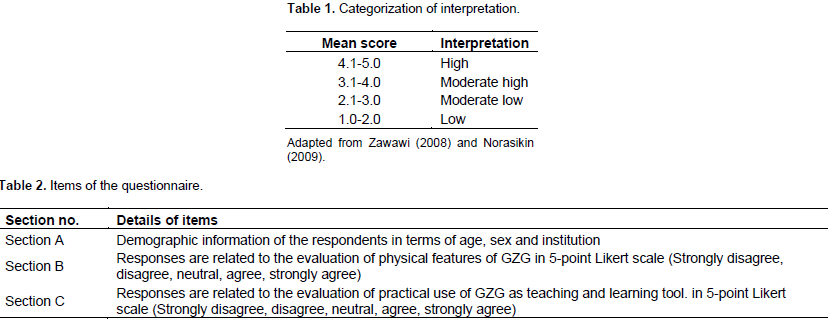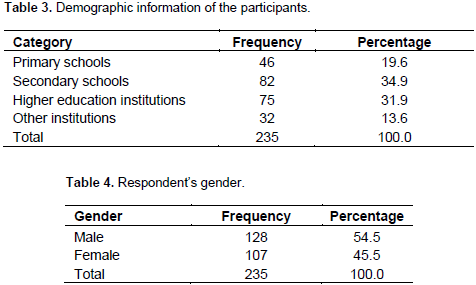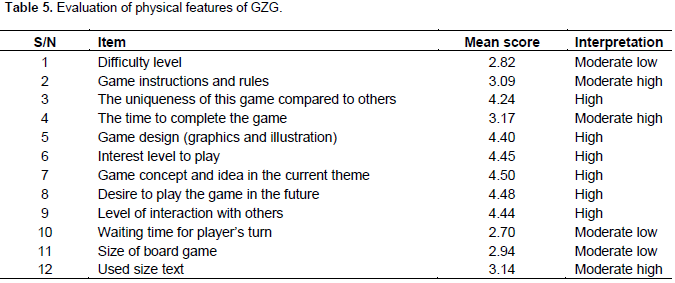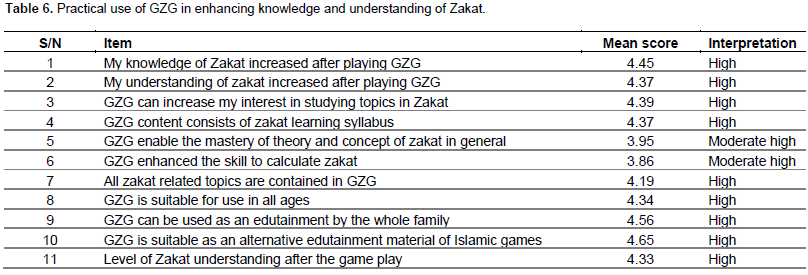Board games have become one of the useful tools in teaching and learning. Many instructors and educators have chosen to use board games to enhance the way of delivering course contents. A board game will help students understand the education concept quickly and get involved in experiential learning, where students can manage and solve problems in an actual situation. This study will focus on the evaluation of a board game, namely Global Zakat Game (GZG) as a Zakat edutainment tool among users at various levels of learning institutions in Malaysia. The respondents were purposively selected among a Malaysian national competition in using Global Zakat Game (GZG) organized at Islamic Science University of Malaysia (USIM) on 8 November 2017. A questionnaire was distributed among 235 participants from various levels of learning institutions during the national event to evaluate the practical use of GZG as a Zakat edutainment tool in increasing their comprehension and understanding on Zakat theories and concepts. The result indicated that the use of GZG as a Zakat edutainment tool has a positive impact on users and players as it helps them to learn more about Zakat theories and concepts between high (4.65) and moderate high (3.95) mean scores. Most of the respondents mentioned that they enjoyed playing GZG as it involves experiential learning. It also can be used as an edutainment tool for learners and society at all ages.
In an effort to educate the young generation, various educational tools have been introduced in this challenging environment, as these materials have been designed to facilitate students in understanding a learning subject. Previously, many instructors assumed that students will be able to understand the whole teaching and learning goals through traditional training methods, but in reality, many students only manage to achieve partial goals. Therefore, an effective approach should be used to encourage and inspire during teaching process (Zainuddin and Idrus, 2017), including the Zakat education. The Zakat is a term used in Islamic finance to refer to the obligation that an individual has to donate a certain mandatory proportion of wealth each year to charitable causes. The use of educational games have attracted researchers’ attention from around the world and perceived as an integrated tool within the teaching and learning process (Prensky, 2001; Pivec et al., 2004; Whitton, 2010; Roslina et al., 2010) with various terms such as ‘game-based learning’ or GBL (Prensky, 2001), ‘edutainment’ and ‘serious games’ (Tsai et al., 2008), and gamification (Hee and Jae, 2014).
In general, gamification is an element of the game implementation process in a subject that is not a game, which is aiming at making it more attractive and joyful for everybody. Gamification in the field of education can be understood as a process of applying elements of the game in conveying knowledge to students. The term gamification first triggered in 2002 by the creators of the game of Briton, Nick Pelling and it became widely used in 2010 (Kamasheva, 2015). Apart from education, gamification method is also used to improve employee’s motivation, relationships with clients in the areas of business, as well as collecting donations for the group. The gamification techniques are also more attractive and popular when people began to incline towards more relaxed and attractive method in their educational setting in order to understand information including Islamic education.
Board games as edutainment tool in education
The implementation of tools such as board games provide a non-threatening, playful and competitive environment where students can learn from their mistakes due to their weaknesses and failures in achieving learning goals (Treher, 2011). A board game is a game involving a counter or token that is placed or moved on a board game provided by a set of instructions. The board games can be classified into two categories that reflect the realities of life or vice versa (Carlos and Awad-Aubad, 2007). In this case, the Global Zakat Game (GZG) is referred to as a board game or an exercise which presents a blend of two streams: education and entertainment merging into one or edutainment. Edutainment is applied in order to teach learners how they should use their own knowledge, analyzing things they learned, combining things they perceived and evaluating things they learned (Charsky, 2010). GZG can be used to supplement existing learning approaches or integrate them into existing curricula. According to Lee (2016), some pedagogical advantages of board games include:
(1) Encouragement of learners to take a problem solving and constructivist approaches in learning.
(2) Instant feedback to correct misconceptions and promote formation of concepts thus increasing learners’ understanding of a subject area.
(3) Increased retention of information through learning by game-playing.
(4) An aid in acquisition and development of cognitive abilities that are not formally taught in education.
(5) Fostering collaborative learning among peers.
(6) Promotes deep learning by arousing learner’s curiosity on certain subjects.
(7) Transforming entertaining play to productive play and extending learning into gaming.
In an era when many students are oriented towards games or simulation, it is the best opportunity to use board games as an edutainment tool. The use of board games has become a popular phenomenon in order to engage the students to fully learn a certain subject. According to Reid et al. (2012), it provides a better learning platform compared to traditional teaching methods. Furthermore, Carlos and Awad-Aubad (2007) pointed out that the traditional teacher-centred learning should be complemented with student-centred board games in order to give students or players the ability to practice self-learning pace. It can be concluded that learning through board games provides a positive impact to students learning abilities. Cook and Olson (2006) also indicated that board games are important tools to provide hands-on and heads-on skills and knowledge development for people on all subjects, as well as very useful, effective and enjoyable for all ages. This is supported by Ab Rahman et al. (2017) who claimed that the use of games as a teaching tool has attracted 96% of the students' interests in learning compared to traditional method, during the first phase of the development process of this game board prototype. As such, the main purpose of this study is to evaluate the Global Zakat Game (GZG) as edutainment board game in enhancing zakat education in Malaysia among 235 participants from various levels of learning institutions during a national event.
Design and development of GZG)
There are various edutainment tools used at educational setting in applying knowledge to learners. The gamification method in education is widely used in Malaysia, as well as abroad as it gives students an understanding on a certain topic. Board games have been used as teaching materials since ancient times because players get to increase their critical thinking, problem-solving, analysis, reasoning, planning and communication skills (Hinebaugh, 2009). The idea of producing this product aroused when looking at the Zakat collection in Malaysia, which has not reached the targeted level. The statistics of Zakat payers in the Federal Territory 2015 shows that only 166,787 people pay Zakat to PPZ-MAIWP from 1.7 million people (PPZ, 2015). Among the factors contributing to the problem are the level of understanding and awareness of the community on the obligation of Zakat is still low.
Hence, awareness and understanding on the importance and obligation of Zakat should be practiced at all age levels, as early as in school to workplace environment. So on 1st August 2016, the researchers from Universiti Sains Islam Malaysia (USIM) have discussed in developing a new innovation in a form of game that can be used in the Malaysian education setting. Various edutainment tools have been used by teachers and educators in enhancing the understanding among the students, generally in the subject of Islamic education, and primarily in the field of Zakat. GZG (Figure 1) is an interactive and informative board game, which can be used as a new Zakat edutainment aid. By playing this game, players will be able to understand the concept of Zakat and strengthen their calculation skills involving calculation of agricultural, livestock, businesses, gold and silver and buried treasure Zakat. It is hoped that GZG will give benefits and insights on Zakat management in Islam.

GZG general rules
This GZG Zakat game has several components which include main game board, two dices, three IQ cards, money notes, reward cards, two dices, and several tokens representing the players. Below are the general rules of this GZG board game:
(1) Question banks are categorized based on three different IQ levels that is, IQ 1 (green), IQ 2 (red) and IQ 3 (blue).
(2) The game has two sections, basic and advance sections.
(3) Players can proceed to move from basic section to advance section once they successfully collect a total amount of $5000 cash and above.
(4) Wealth acquisition in three methods:
(a) Salary: Income is paid when players land on the spaces marked “salary” which is based on careers.
(b) Business: Revenue from product and business.
(c) Reward: If players answer question on IQ card correctly, they are given an option to either keep award cards or redeem cash. The value of cash is determined based on the IQ card level.
(i) IQ Card 1 = $100
(ii) IQ Card 2 = $200
(iii) IQ Card 3 = $300
(5) Dice system: Dice is used for each round to determine
spaces that players can pass over. If a player rolls a two of a kind (both dice show the same number), they can roll the dice once again for additional moves. However, if the dice shows doubles for two times in a row, the player will lose their turn.
(6) Throughout the game, players will pass over labelled spaces. Each space has different meanings as follows:
(a) Start: The game starts from here.
(b) Salary: Players are paid salary by the bank (Zakat agent) based on their careers.
(c) Fines: Players are required to pay fines.
(d) Order: Players are required to pick order cards and follow the instructions.
(c) Business: There are three functions of business spaces:
(i) Players who lands on “unowned” business spaces are given an option whether to buy business or not by using their salary or wealth generated from businesses.
(ii) Players who land on their own business spaces receive revenues as stated in business cards.
(iii) Players who land on other players’ business spaces must pay for that product (as stated in business card) to the owners.
(a) IQ – IQ spaces are labelled with different colours. Each respective colour has different level of questions. Each correct answer will be rewarded. However, there is no penalty for false answer given. Players have an option to either keep the reward cards or redeem cash.
(b) Zakat calculation – Players who land at this space must do the followings:
(i) Calculating all their wealth and if the amount reaches nisab (the minimum amount for a Muslim net worth to be obliged to pay Zakat), players must make Zakat payment to the bank (Zakat agent) in cash.
(ii) Record the amount of Zakat payment.
(iii) If the players do not have cash, they are considered on debt and need to pay Zakat when cash is available.
(a) Failed to pay Zakat: Lose one round. If player insists to continue the game without getting suspended for one round, player must pay $200 for arrears/outstanding Zakat payment.
(b) Car breakdown: Lose one round or pay $500.
(7) Players can sell their business spaces to bank officer or other players at half price from the real value.
A national-level GZG contest was organized on 8th November 2017, at Universiti Sains Islam Malaysia (USIM). Various categories of participants from different education levels including primary schools, secondary schools and higher education institutions, as well as the public participated in this contest. The researchers conducted a short briefing session on how to play GZG and asked permission from all participants to be respondents for the survey. Once the participants had formed their groups, the contest began. During the contest, the researchers conducted observations to investigate the engagement of participants and their progress. Data was collected after each game had finished and all participants were asked to fill in a paper-based questionnaire given by the researchers. The questionnaire used was adapted from Game Evaluation Sheet (2017). The research instrument then was validated by an expert at IIUM in the field through an email correspondence. The Cronbach Alpha score for the instrument is also high at 0.83. The interpretation of the mean scores in this study was done based on categorization of interpretation as shown in Table 1. A questionnaire was developed on the basis of the literature review and validated by experts who have academic or industrial backgrounds and abundant experience in teaching or conducting professional practice in the field of Zakat. The questionnaire consisted of the following sections in Table 2. The collected data was analyzed by using the IBM statistical package for social sciences (SPSS) Statistics 20 software. A descriptive analysis was performed in order to characterize the behavior of each variable measured.

The analyzed results and findings in this study are portrayed as below:
Demographic profile of overall respondents
A total of 235 respondents between the age of 10 to 47 years old (107 female and 128 male) volunteered for the study. It can be observed that most of the participants came from secondary schools (34.9%), followed by primary schools (19.6%), higher education institutions (31.9%) and others (13.6%) as presented by Table 3. Table 4 reported the distribution of gender among respondents in this study.

Evaluation of physical features of GZG
Table 5 indicates the evaluation of physical features of GZG among users. 13 items were evaluated consisting of various aspects of the physical features in this board game. Based on Table 5, various scores of means are reported with high, moderate high and moderate low interpretations. In overall, the evaluation of physical features of this board game is very good except 3 items which are: level difficulty, waiting time for player’s turn and size of board game. This low score of result may be affected by the existing 3 level of IQ cards in the game in addition to the physical size of board game that may be not suitable for adult players.

The practical use of GZG in enhancing knowledge and understanding of Zakat
Table 6 indicates the responses from the respondents regarding the practical use of GZG in enhancing knowledge and understanding of Zakat. Based on Table 6, various scores of means are reported with high, moderate high and moderate low interpretations. In overall, the evaluation practical use of GZG as teaching and learning tool is between high and moderate high. The items are related to practical use of this board game in enhancing zakat knowledge and understanding among the players as users.

From the results, the respondents agree that the GZG board game can be used as an effective learning edutainment tool for in enhancing knowledge and understanding of Zakat among various levels of users from primary schools, secondary schools, higher learning institutions and other public and private institutions such as banks and Zakat collection agencies. The GZG board game provides a positive impression to the respondents in learning theories and concepts on Zakat education. Furthermore, the majority of respondents mentioned that they enjoyed playing GZG. Based on the observations done throughout the game, respondents were consistently focused on their objectives and committed to the game. Based on the findings, the researchers will take into account that GZG needs to be improved in terms of the design of the board, instructions and game characteristics. In terms of font size used, the low score of evaluation may be caused by the adult learners from the public institutions who prefer larger and readable fonts in the game board. As such, different version of game may need to be designed for specific category of adult users. From the observation during the event, GZG enables players to experience, reflect on their inner characteristics, fully express and reveal their emotions, ideas, experiences and behaviors. The players also can reflect on several key elements such as teamwork, trust, responsibility, problem-solving, decision-making, leadership, goal setting, and communication. This players’ practical reflections during the competition among various levels of players from schools, colleges, universities and colleges showed an acceptance level of GZG board game as an effective edutainment tool in enhancing zakat education in Malaysia, as perceived by them.
This paper presents a research evaluation that was conducted to study the practical use of a board game known as GZG in enhancing zakat knowledge and understanding among the players as game users among various background of users and learners in Malaysia. Hopefully by introducing GZG at every level of society, particularly in educational institutions, will be the trigger for innovation in the context of Islamic education that implements the concept of education while playing and entertaining. GZG is not just a matter of use for Malaysians only, but it is inclusive and can be used by people regardless of race. This global nature exists when GZG is not only created in Malay, but even English and Arabic versions. The goal of developing creative methods in the Islamic education world needs to be achieved and inspired by all researchers and communities who not only want to see the fiqh of Zakat, but the whole of Shari'a knowledge is understood and translated by practice based on clear and true understanding. New innovations introduced in the field of Zakat like GZG, can be a model and a special guide to scholars and Muslims to create a more creative and effective way of delivering knowledge.